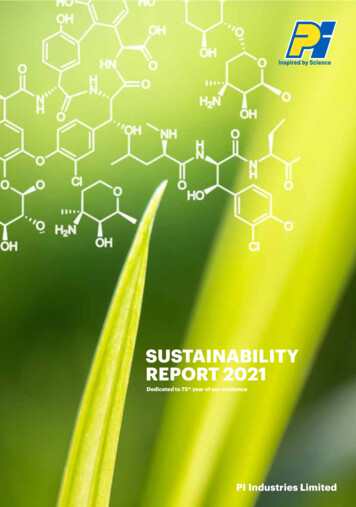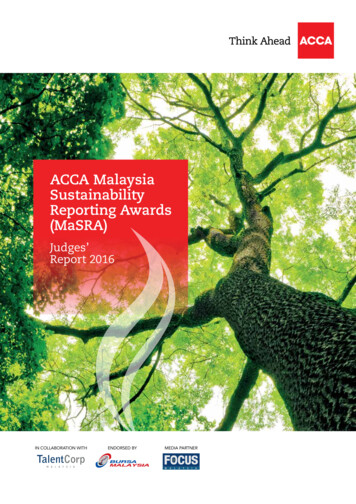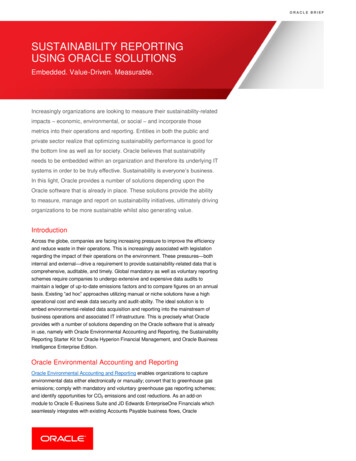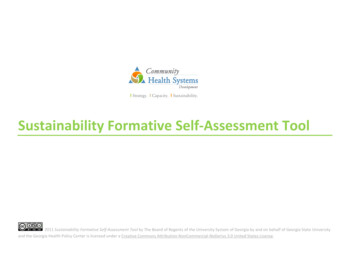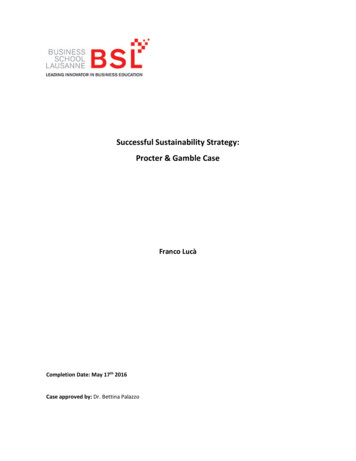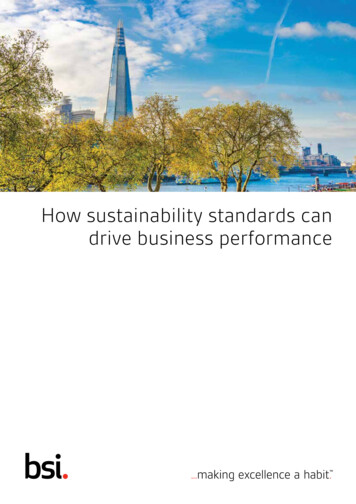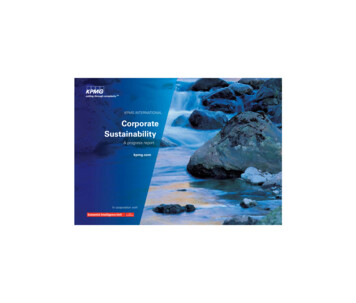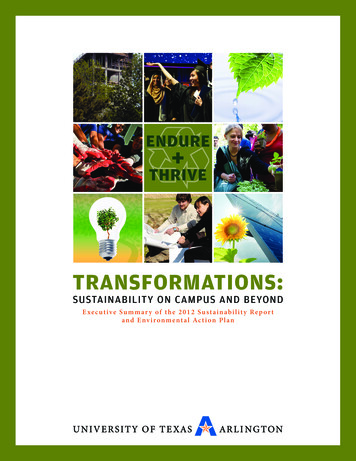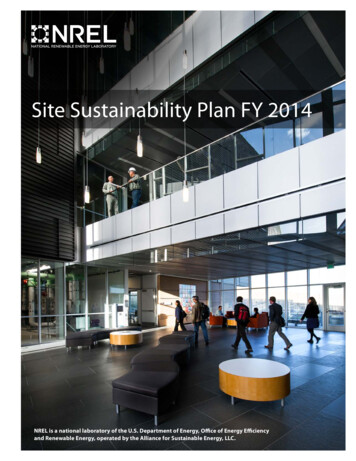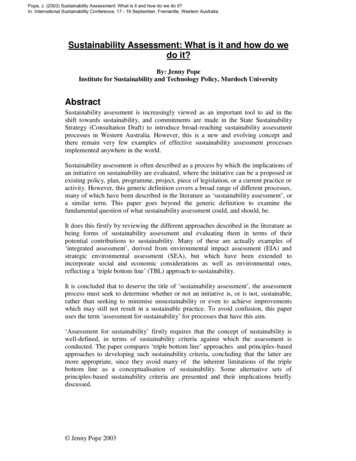
Transcription
Pope, J. (2003) Sustainability Assessment: What is it and how do we do it?In: International Sustainability Conference, 17 - 19 September, Fremantle, Western Australia.Sustainability Assessment: What is it and how do wedo it?By: Jenny PopeInstitute for Sustainability and Technology Policy, Murdoch UniversityAbstractSustainability assessment is increasingly viewed as an important tool to aid in theshift towards sustainability, and commitments are made in the State SustainabilityStrategy (Consultation Draft) to introduce broad-reaching sustainability assessmentprocesses in Western Australia. However, this is a new and evolving concept andthere remain very few examples of effective sustainability assessment processesimplemented anywhere in the world.Sustainability assessment is often described as a process by which the implications ofan initiative on sustainability are evaluated, where the initiative can be a proposed orexisting policy, plan, programme, project, piece of legislation, or a current practice oractivity. However, this generic definition covers a broad range of different processes,many of which have been described in the literature as ‘sustainability assessment’, ora similar term. This paper goes beyond the generic definition to examine thefundamental question of what sustainability assessment could, and should, be.It does this firstly by reviewing the different approaches described in the literature asbeing forms of sustainability assessment and evaluating them in terms of theirpotential contributions to sustainability. Many of these are actually examples of‘integrated assessment’, derived from environmental impact assessment (EIA) andstrategic environmental assessment (SEA), but which have been extended toincorporate social and economic considerations as well as environmental ones,reflecting a ‘triple bottom line’ (TBL) approach to sustainability.It is concluded that to deserve the title of ‘sustainability assessment’, the assessmentprocess must seek to determine whether or not an initiative is, or is not, sustainable,rather than seeking to minimise unsustainability or even to achieve improvementswhich may still not result in a sustainable practice. To avoid confusion, this paperuses the term ‘assessment for sustainability’ for processes that have this aim.‘Assessment for sustainability’ firstly requires that the concept of sustainability iswell-defined, in terms of sustainability criteria against which the assessment isconducted. The paper compares ‘triple bottom line’ approaches and principles-basedapproaches to developing such sustainability criteria, concluding that the latter aremore appropriate, since they avoid many of the inherent limitations of the triplebottom line as a conceptualisation of sustainability. Some alternative sets ofprinciples-based sustainability criteria are presented and their implications brieflydiscussed. Jenny Pope 2003
1. IntroductionSustainability assessment is increasingly advocated as an important tool to contributeto the shift towards a more sustainable society. The Western Australian StateSustainability Strategy (Consultation Draft) includes commitments to introducebroad-reaching sustainability assessment processes in Western Australia, anddescribes a future in which “sustainability assessment forms the basis of allgovernment decisions and is embedded into all levels of government activity”(Government of Western Australia 2002, p41). However, this is a new and evolvingconcept and there remain very few examples of effective sustainability assessmentprocesses implemented anywhere in the world.Available definitions of sustainability assessment include: “Sustainability assessment is a tool that can help decision-makers andpolicy-makers decide what actions they should take and should not take in anattempt to make society more sustainable” (Devuyst 2001a, p9); or“The aim of sustainability assessment is to ensure that plans and activitiesmake an optimal contribution to sustainable development” (Verheem 2002a).However, as this paper will seek to demonstrate, these definitions are sufficientlygeneric to describe a broad range of different processes, many of which have indeedbeen called ‘sustainability assessment’ or some similar term in the literature. Thispaper seeks to examine the concept of sustainability assessment more deeply, usingexamples of processes discussed in the literature to address the fundamental questionof what sustainability assessment could, and should, be.The concept of sustainability, or sustainable development, is clearly the basis ofsustainability assessment. Sustainable development was first described by theBrundtland Commission in 1987 as “development that meets the needs of the currentgeneration without compromising the ability of future generations to meet their ownneeds” (WCED 1987). Sustainability demands the protection of resources andecological integrity over the long term, combined with great improvements in humanwell-being, especially among the poor (Gibson 2001).Since the Brundlandt Commission, many alternative definitions of sustainability havebeen proposed and diverse interpretations of the concept made. Many of these arebased upon the ‘three pillar’ or ‘triple bottom line’ (TBL) concept of sustainability,which requires the integrated consideration of environmental, social and economicissues. The implications of different definitions and interpretations of sustainabilitythat underpin the different approaches to sustainability assessment will be discussed.The theory of sustainability assessment currently available in the literature has largelyevolved from work undertaken by practitioners of environmental assessment (EA),including project environmental impact assessment (EIA), and more recently strategicenvironmental assessment (SEA), which in turn has been influenced by policyanalysis techniques (Sheate et al 2001; Sheate et al 2003). Therefore the approaches toso-called sustainability assessment described in the literature strongly reflect theseprocesses. Jenny Pope 2003
The purpose of this paper is to clarify what the term ‘sustainability assessment’should mean if it is to fulfil its potential as a tool for promoting sustainability. Suchclarification is an essential prerequisite to meaningful discussions on the developmentof sustainability assessment processes in Western Australia and elsewhere.It begins by reviewing the practices of EIA and SEA and then examines the‘integrated assessment’ processes that have been derived from EIA and SEA by theinclusion of social and economic, as well as environmental, considerations in theprocess. These integrated assessment processes are discussed in terms of their aimswith respect to sustainability, and the question asked as to whether they go farenough. The TBL approach to sustainability, upon which these integrated assessmentprocesses are based, is considered, and alternatives to the TBL approach are alsodiscussed.2. Environmental Assessment ProcessesWhen considering the concept of sustainability assessment and reviewing theliterature available on the subject, it is useful to consider its conceptual origins.Sustainability assessment is generally viewed as a tool in the ‘family’ of impactassessment processes, closely related to EIA applied to projects and SEA applied topolicies, plans and programmes (PPP’s) (Therivel and Partidario 1996).The literature reflects a widely-held belief that environmental assessment processessuch as EIA and SEA can and do make valuable contributions towards sustainability.In some cases it is suggested that this contribution arises directly from the integrationof environmental considerations into decision-making (see for example Sheate et al2003; Wood 2002), while others suggest that EIA and SEA provide a sound basis thatcan be extended to include broader sustainability concerns (Gibson 2001; Verheem2002a; Partidario 2003).The following sections briefly describe and discuss the two major forms ofenvironmental assessment, EIA and SEA, to provide the necessary background forsubsequent discussions the contribution of environmental assessment to sustainability.2.1 Environmental Impact Assessment (EIA)Environmental impact assessment (EIA) is generally applied to project proposals and“aims to identify the significant environmental effects of proposed activities todecision makers and the public and to identify ways to avoid or reduce environmentaldamage” (Devuyst 1999, p460). EIA can be considered to be a ‘baseline-led’ processwhich typically involves comparing the impacts of a proposed action with baselineconditions (Smith and Sheate 2001), and to determine whether or not the potentialimpacts are acceptable, unacceptable, or manageable with appropriate controls (Sippe1999).EIA processes have been embedded in legislation around the world for the past 30years and have been generally very successful in identifying and mitigating thepotential environmental impacts of project proposals (Sippe 1999).However, the limitations of traditional EIA are also well understood and documented.Dalal-Clayton and Sadler (2002) discuss some of the factors constraining traditional Jenny Pope 2003
EIA, particularly the late stage in the decision-making process at which EIA isapplied, which means that questions such as whether, where and what type ofdevelopment should occur have already been addressed.Dovers goes further in suggesting that: “EIA is fundamentally flawed in beingorientated almost totally towards projects. EIA misses regional impacts, cumulativeimpacts of multiple projects over time, and may allow environmental death by athousand small cuts. EIA rarely caters for consideration of alternatives to a project,but leads to either approval or rejection, or amelioration of impacts deemedunacceptable” (Dovers 2002, p24).The need to assess the environmental implications of decisions made at much higherlevels of decision-making was recognised, and the concept of strategic environmentalassessment (SEA) has evolved rapidly over the past decade to address this gap and toprovide a means for assessing the environmental implications of policies, plans andprogrammes (PPP’s) (Therivel and Partidario 1996).2.2 Strategic Environmental Assessment (SEA)As already briefly discussed above, strategic environmental assessment (SEA) isbroadly defined as the environmental assessment of policies, plans and programmes(PPP’s) (Therivel and Partidario 1996), in contrast with EIA, which is generallyapplied to project proposals.Noble describes the theoretical relationship between EIA and SEA as follows:“Ideally SEA and EIA are considered in sequence where SEA proactively examines abroad range of alternatives and selects the preferred course of action, and EIA isinitiated “reactively” to determine in greater detail the potential impacts of thepreferred alternative” (Noble 2000, p210).This is an example of ‘tiering’, also known as ‘the trickledown effect’ or ‘verticalintegration’, by which assessments conducted at the higher levels of decision makinginfluence and guide those conducted at the lower levels. This should ensure thatenvironmental issues are dealt with at the appropriate level, resulting in a streamlinedprocess with minimal repetition (Therivel and Partidario 1996; Sadler and Verheem1996; Marsden 2002; Nooteboom 2000).Partidario distinguishes between different levels of decision making as follows:Road-map with defined objectives, set priorities, rules and “Policy:mechanisms to implement objectives; Planning:Priorities, options and measures for resource allocationaccording to resource suitability and availability, following the orientation,and implementing, relevant sectoral and global policies; Programme: Organized agenda with defined objectives to be achievedduring programme implementation, with specification of activities andprogramme investments, in the framework of relevant policies and plans; Project:A detailed proposal, scheme or design of any developmentaction or activity, which represents an investment, involves constructionworks and implements policy/planning objectives” (Partidario 2003, p8) Jenny Pope 2003
Despite the fact that many writers have also pointed out that tiering does not functionquite so neatly in practice (Nooteboom 2000; Noble 2002; Jones 2003), it remains animportant concept for planning and assessment processes.Within the broad definition of SEA as environmental assessment of PPP’s there hasbeen considerable debate as to how it should be approached (Sheate et al 2003) and asa result “there are several definitions of SEA stemming from the many ideas over itsrole and purpose (Sheate et al 2001, p6).For example, it is recognised that SEA can be used as a tool to evaluate PPP’s alreadydeveloped or as an integral part of the development, assessment, amendment,implementation, monitoring and review of PPP’s, i.e. applied at all stages of the lifeof a PPP (Sheate et al 2003). However, the use of SEA as a proactive design toolrather than a reactive evaluation tool tends to be favoured in the literature (DalalClayton and Sadler 2002; Brown and Therivel 2000) In the definitions providedabove, Partidario’s use of the term ‘planning’ rather than ‘plans’ is deliberate, as sheseeks to emphasise the importance of the planning process rather than the outcome ofthat process (the plan). Similarly, she advocates that SEA should be part of thestrategic planning process rather than an evaluation applied to a completed plan(Partidario 2003).For the purposes of this paper, and based upon the work of a number of writers, thedifferent forms of SEA can be considered to fall into two broad categories: ‘EIAdriven’ and ‘objectives-led’ (Partidario 1999; Partidario and Eggenberger 2000;Sheate et al 2001; Sheate et al 2003).2.2.1 EIA-driven SEAEIA-driven SEA is typically applied as a reactive process that aims to evaluate theenvironmental impacts of a policy, plan or programme for which decision-making iswell advanced or complete against a baseline, to evaluate the acceptability of theimpacts and to identify potential modifications to improve the environmentaloutcomes (Sheate et al 2001; Sheate et al 2003; Sippe 1999). Essentially, it is aproject-level EIA process applied to a PPP, or “EIA writ large” (Sheate et al 2003).Partidario (2003) suggests that an EIA-driven approach is reflected in some earlydefinitions and SEA legislation, including The US National Environmental Policy Act(1969).2.2.2 Objectives-led SEAThe literature also describes a range of SEA processes that can be considered to be‘objectives-led’. For the purposes of this paper, the term ‘objectives-led’ will be usedto refer to SEA in which the potential impacts of a policy, plan, programme orstrategy are assessed against a series of aspirational environmental objectives, ratherthan against a baseline (Smith and Sheate 2001; Twigger-Ross 2003). Objectives-ledSEA is derived from policy analysis rather than from EIA (Sheate et al 2001; Sheateet al 2003). Clearly, a well-defined set of environmental objectives is an importantprerequisite for this form of SEA.Reflecting the principles of tiering discussed earlier, these objectives must beconsistent and compatible with those applied at higher and lower levels of decision- Jenny Pope 2003
making. Ideally, environmental assessments conducted at higher levels of theplanning hierarchy would establish appropriate objectives for decision-makingprocesses at the lower levels, although it is recognised that processes are rarely sostreamlined in practice (Nooteboom 2000).Objectives, or goals, describe the purpose of a policy, plan or programme, and for thepurposes of this discussion the two terms will be considered synonymous. Theyshould reflect a broad strategic vision, such as ‘sustainability’ or ‘sound economicgrowth’ (Noble 2000) and should also reflect a balance between community values,development objectives and national and global trends (Partidario 2003).Therivel (1996) points out that while some objectives may be explicitly stated, otherswill be implicit, resulting from a number of incremental decisions made in politicalprocesses. The full list of objectives for a PPP can be derived from the explicitobjectives, discussions with the competent authority and decision-makers, higher andlower level PPP’s and other sources.2.2.3 Environmental Assessment and SustainabilityAs previously discussed, the potential for environmental assessment processes such asEIA and SEA to contribute to sustainability has been widely recognised. Somebelieve that this contribution arises directly from the integration of environmentalconsiderations into decision-making (see for example Sheate et al 2003; Wood 2002),while others suggest that EIA and SEA provide a sound basis that can be extended toinclude broader sustainability concerns (Gibson 2001; Verheem 2002a; Partidario2003).Gibson points out that “environmental assessment processes .are among the mostpromising venues for application of sustainability-based criteria. They are anticipatoryand forward looking, integrative, often flexible, and generally intended to forceattention to otherwise neglected considerations” (Gibson 2001, p1) although he alsorecognises that “environmental assessments are not the only vehicles for specifyingsustainability principles, objectives and criteria” (Gibson 2001, p19).The two views of the potential contribution of environmental assessment tosustainability correspond to two different concepts of sustainability. It is important tonote at this point that sustainability is a difficult concept to define in a way that ismeaningful and sufficiently practical to allow sustainability to be operationalised. Ithas been suggested that the difficulty arises because sustainability is a concept like‘love’, ‘hope’ or ‘freedom’, and as such tend to remain ‘fuzzy’ until applied in aspecific context (Government of Western Australia 2002). This situation is not aidedby the fact that many alternative theoretical formulations and applications ofsustainability have been developed, which are founded upon common concerns andprinciples, but which have different emphases (Gibson 2001).This paper does not attempt to provide a detailed analysis of alternativeconceptualisations of sustainability, but does seek to highlight where appropriate howthis alternative views are embedded into the various documented approaches to‘sustainability assessment’. Jenny Pope 2003
For example, the suggestion that environmental assessment itself contributes tosustainability reflects the view that “environmental impacts are at the core ofsustainability concerns” (Sadler 1999, p12) and that “specifically, the concern is aboutthe continuing or accelerating throughput of energy and raw materials, beginning withresource extraction and ending with pollution and residuals” (Sadler 1999, p15). Thisis consistent with a ‘deep green’ ecological sustainability model that can berepresented as three concentric circles, the outer representing ecology, the middlerepresenting society and the inner representing the economy (Gibson 2001). This viewof sustainability emphasises that the source and sink functions provided by naturalresources are finite, and that sustainability therefore means finding a way to livewithin the limits of natural systems (Sadler 1999; Diesendorf 1997).On the other hand, the suggestion is often made that environmental assessment shouldcontribute to sustainability by extending its scope to include social and economicconsiderations along with environmental ones (Marsden and Dovers 2002). Thisreflects the ‘three pillar’ or ‘triple bottom line’ (TBL) model of sustainability, whichis often conceptualised as three intersection circles repesenting the environment,society and the economy (Gibson 2001). This form of extension of environmentalassessment results in a form of triple bottom line integrated assessment (TwiggerRoss 2003).The term ‘triple bottom line’ was popularised by John Elkington of SustainAbility. Inhis book Cannibals with Forks: The Triple Bottom Line of 21st Century Business, hedescribes the evolution of the concept within a business context:“The sustainability agenda, long understood as an attempt to harmonize thetraditional financial bottom line with emerging thinking about theenvironmental bottom line, is turning out to be much more complicated thansome early business enthusiasts imagined. Increasingly, we think in terms of a‘triple bottom line’, focusing on economic prosperity, environmental quality,and – the element which business has tended to overlook- social justice”(Elkington 1997, p2).Whereas the Brudtland Commission presented a two pillar model reflectingenvironment and development concerns, the three pillar triple bottom line modelseparates the development issues into social and economic factors, emphasising that“material gains are not sufficient measures or preservers of human well-being”(Gibson 2001, p7).For the purposes of this paper, the triple bottom line can be considered aninterpretation of sustainability that places equal importance on environmental, socialand economic considerations in decision-making.By far the majority of processes attempting to expand environmental assessment toaddress broader sustainability issues reflect a triple bottom line approach tosustainability. Triple bottom line integrated assessment is examined further in thefollowing section. Jenny Pope 2003
3. Triple Bottom Line Integrated AssessmentThe integration of environmental, social and economic considerations within anassessment process is an example of ‘horizontal integration’, in contrast with the otherforms of integration identified by Lee (2002): ‘vertical integration’ (also known as‘tiering’ or the ‘trickledown effect’ as discussed previously) and ‘integration intodecision-making’ which embodies the concept of assessment processes as afundamental component of the decision-making process. Horizontally integratedassessment processes for sustainability reflect the widely-recognised principle thatsustainability assessment requires the consideration of environmental, social andeconomic issues (Sadler 1999; Devuyst 1999), and reflect a triple bottom lineapproach to sustainability.Such extension to include all three pillars of the triple bottom line could conceivablyoccur within all three of the environmental assessment processes described thus far:EIA, EIA-driven SEA and objectives-led SEA. For the purposes of this discussion,two terms will be used: ‘EIA-driven integrated assessment’, derived from EIA andEIA-driven SEA, and ‘objectives-led integrated assessment’. Although the latter isderived from objectives-led SEA, an objectives-led integrated assessment approachcould equally be applied to project-level proposals.Both of these approaches can be considered to be examples of ‘sustainabilityappraisal’, as defined by Sheate et al (2001); ‘integrated sustainability appraisal’ asdiscussed by Eggenberger and Partidario (2000) or ‘integrated impact assessment’(Sheate et al 2003). Similarly, Lee (2002) uses the term ‘sustainability assessment’ todescribe a special form of horizontally integrated assessment, which takes intoconsideration economic, environmental and social impacts, a definition which appliesequally to EIA-driven and objectives-led integrated assessment.The term ‘integration’ implies that integrated assessment should be more than the sumof separate environmental, social and economic assessments. Eggenberger andPartidario (2000) remind us that “the principle that the sum of the parts does not equalthe whole is widely acknowledged” and suggest that “integrating in fact means that anew entity is created where new relationships are established, bearing on individualentities that have specific characteristics and specific dynamics but in combination actin a different way”.Brookes (2002) supports this view, suggesting that integrated assessments shoulddemonstrate added value; that is they should be more than the sum of their parts. Inother words, integrated assessment should consider the relationships, synergies andconflicts between the impacts (Gibson 2001).The aim of integrated assessment is articulated by Post et al (1997): “It aspires todescribe – from the perspective of an identified problem or proposed project – therelations between the human communities concerned, their economic organizationand their actual resource base. It qualifies, quantifies, and, as far as possible, valuesthe effects of proposed and alternative interventions on the three (economic, socialand natural) subsystems and their intersystem relations. It attempts to identifybeneficial interventions and to fully expose unavoidable trade-offs”. Jenny Pope 2003
Therefore, both EIA-driven and objectives-led integrated assessment should not onlyconsider the environmental, social and economic implications of proposals, but shouldalso examine the interrelations between these three pillars of the triple bottom line. Inthe case of EIA-driven integrated assessment, this means that potential interlinkagesbetween TBL impacts must be identified, while objectives-led integrated assessmentalso requires the identification of interlinkages between TBL objectives.The two broad approaches to triple bottom line integrated assessment are discussed inmore detail below. Examples of their application in practice are also provided.3.1 EIA-driven Integrated AssessmentEIA-driven integrated assessment is analogous to EIA and EIA-driven SEA, exceptthat social and economic impacts are considered as well as environmental ones, in anintegration way. George describes the application of EIA-driven integratedassessment to international trade agreements, noting that “the prime aim of such anappraisal, often referred to as a sustainability impact assessment (SIA) is to identifymitigation measures through which adverse impacts might be minimised or avoided”(George 2001, p96).As already discussed, to be truly integrated, the interrelations between the three‘pillars’ of impacts must be considered (George 2001), since it has been recognisedthat “the combined impacts, positive and negative, of the sets of measures as a whole,are likely to be more than the simple sum of the impacts of their constituent measuresbecause of synergistic effects” (Lee and Kirkpatrick 2001).The difficulty of developing and conducting EIA-driven integrated assessmentprocesses in practice has been recognised. This may be due to the fact thatjurisdictions which do assess the social and economic, as well as environmentalimpacts of proposals tend to do conduct three separate assessment processes, andtherefore inconsistencies in the methods and paradigms of sectoral assessmentprocesses may inhibit implementation of more integrated approaches (Lee 2002).Recognising this, Eggenberger and Partidario (2000) identify five different levels ofintegration: substantive, methodological, procedural, institutional and policy, andsuggest that these can be progressively implemented. Similarly, Scholten and Post(yeear?) propose a staged approach to the integration of separate assessmentprocesses, beginning with integration of timing of individual sectoral assessmentprocesses, although recognising that this will not guarantee good communication orgood process. The next stage would bec a detailed scoping at the commencement ofany assessment process to identify alternatives which consider cross-cutting issuesand which form the basis of the sectoral assessments.If the respective impact assessment processes are not integrated effectively, then thisform of ‘integrated’ assessment is reduced to three separate impact assessments, eachgenerating data relating to the potential environmental, social and economic impactsof the proposal or initiative. The three sets of data must then be ‘integrated’ in someway after it has been collected in order to reach a decision as to whether or not theproposal or initiative is acceptable within a sustainability context. Jenny Pope 2003
It has been pointed out that some trade-offs are inevitable in this situation (Gibson2001). While Post et al’s (1997) definition of integrated assessment discussedpreviously suggests that integrated assessment aims to fully expose trade-offs, othersgo further in suggesting that trade-offs should be minimised by an integratedassessment process (Government of Western Australia 2002).Several writers have recommended the use of tools such as multi-criteria analysis(MCA) to aid the integration process (Twigger-Ross 2003), while others haveproposed criteria to guide decisions regarding trade-offs (Gibson 2001). However, theintegrated consideration of triple bottom line impacts remains a challenging task.EIA-driven integrated assessment process should result in acceptable outcomes withrespect to environmental, social and economic baselines. However, as George pointsout: “For this type of activity, the term sustainability appraisal, or sustainabilityimpact assessment, is shorthand for saying that all three of the sustainabledevelopment spheres are evaluated. It does not necessarily mean that the appraisalevaluates a proposal against sustainable development objectives” (George 2001, p96).Therefore, contributions to sustainability may be limited to minimising negativeoutcomes rather than to maximising positive ones.3.2 Objectives-led Integrated AssessmentObjectives-led integrated assessment reflects a desire to achieve a particular vision oroutcome defined by integrated environmental, social and economic objectives. Itassesses the extent to which the implementation of a proposal contributes to thisvision, in contrast with EIA-driven integrated assessment which aims to ensure thattriple bottom line impacts of a proposal are acceptable compared with baselineconditions.An objectives-led approach reflects a concept of sustainability as a goal, or series ofgoals, to which society is aspiring. As Gibson says: “
Institute for Sustainability and Technology Policy, Murdoch University Abstract Sustainability assessment is increasingly viewed as an important tool to aid in the shift towards sustainability, and commitments are made in the State Sustainability Strategy (Consultation Draft) to introduce broad-reaching sustainability assessment
